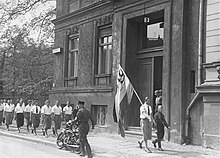Institute for Sexology

Magnus Hirschfeld's Institute for Sexology was a private institution in Berlin . It was opened on July 6, 1919 and, when it was looted, destroyed on May 6, 1933 in the course of the book burnings by the National Socialists . With this institute, Hirschfeld, as a doctor and a sex reformer who had been committed since the end of the 19th century, had fulfilled a personal dream that he had developed and cherished for a long time: contrary to the most adverse current trends, to contribute scientifically to the establishment of an institutionalized sexology and to “promote scientific research for the whole Sexual life and education in this area “to provide a place and a legally protected and financially secure framework.
The establishment of the institute was the first and, until after the Second World War , the only one of its kind. What was spared when the books were burned on May 10, 1933 on Opernplatz and was not sold off in November by the subsequent foreclosure auction by the Berlin tax office to collect recalculated tax debts at the latest during the battle for Berlin . Today there is no longer even the building of the former Villa Joachim in Berlin's Tiergarten , the temporary Palais de Ville of Prince von Hatzfeldt, which Hirschfeld had acquired and converted . It was on the corner of Beethovenstrasse 3 and In den Zelten 10.
The only reminder of the Hirschfeld Institute is a memorial plaque, which was erected near the former site 75 years after it was founded on July 6, 1994.
Structure and organization
The institute was supposed to be a scientific research facility, but contrary to Hirschfeld's wishes and the provisions of the foundation, it did not become a scientific facility. First and foremost, it was an outpatient facility for advice on sexual problems and for the examination, assessment and treatment of all sexual disorders. As an archive for collection, viewing and processing as well as a museum for the demonstration of sexual science publications and other relevant documents of all kinds, it was a magnet in Berlin during the “ Roaring Twenties ”. For the advanced training of doctors it served as a teaching and training center, for interested laypeople as a lecture venue, whereby Hirschfeld - like his most important colleague for a long time and Arthur Kronfeld , who worked at the institute until 1926 - also gave lectures in adult education centers and other educational institutions in Berlin and Germany worked far beyond that. It was also the organizational focus for all sexual reform activities and organizations at the time, their advocates (such as Max Hodann ) and, in some cases, beyond. After all, it was and should be: a refuge for people in sexual need.
literature
- Daria Kinga Majewski: Trans Warriors. What the 100th anniversary of the establishment of the Institute for Sexology has to do with the current ministerial attempt to change the transsexual law. concrete , 7, 2019, p. 54f. (detailed on Hirschfeld)
Web links
- Brief description of the Institute for Sexology by Magnus Hirschfeld on the websites of the Magnus Hirschfeld Archive for Sexology at Humboldt University Berlin.
- Detailed internet documentation on the institute of the Magnus Hirschfeld Society Berlin .
- How Hirschfeld's Sexology Institute was demolished and destroyed (May 6, 1933) . From: Günter Grau (Ed.): Homosexuality in the Nazi era. Documents of discrimination and persecution (= The time of National Socialism. Fischer pocket books. History 11254). Fischer-Taschenbuch-Verlag, Frankfurt am Main 1993, ISBN 3-596-11254-0 (Revised new edition. (= Fischer 15973 The time of National Socialism ). Ibid 2004, ISBN 3-596-15973-3 ).
Individual evidence
- ↑ Lorenz Pfeiffer: Students of the German University for Physical Education as participants in the 'Action against the un-German spirit' in the spring of 1933 in the “2008 Yearbook of the German Society for the History of Sports Science”: p. 50 ff.
- ↑ Götz Borgwardt: Bernhard Schapiro (1888–1966): Talmudic scholar - doctor - pioneer of the hormone treatment of cryptorchidism. In: Würzburger medical history reports 23, 2004, pp. 393–411; here: pp. 401–403.
